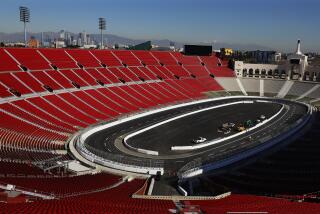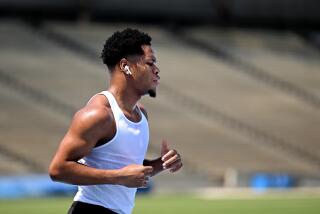The Chase Continues : Motocross’ Glover Must Have Coliseum Victory in Bid for Title
- Share via
El Cajon is a city of fewer than 75,000 people on the inland side of San Diego, yet it is home for four of the top seven riders in the Supercross Series, tops in American motocross.
Broc Glover, second behind Jeff Ward of Mission Viejo going into Saturday night’s Miller Superbowl of Motocross in the Coliseum, is the kingpin of the El Cajon four. He has won two Superbowls in the Coliseum and five national outdoor championships, the first when he was a 17-year-old high school classmate of Olympic diving champion Greg Louganis at Valhalla High.
The others are Ron Lechien, third; Rick Johnson, fourth; and Scott Burnworth, seventh.
They are not all teammates, however. Glover and Johnson ride Yamahas, Lechien a Honda and Burnworth a Suzuki.
Why El Cajon?
“We are all lucky to live where it’s so easy to find a place to ride,” Glover said. “El Cajon is perfect. It’s right on the edge of the hills and mountains back of San Diego. Johnson and I have our own track 10 minutes from where we live. We built it to train on for Supercross, but within a few more miles there are five or six good places to ride. And the local AMA district is very active in scheduling a lot of races, especially for new riders.
“Motocross is very well known in El Cajon. I would venture to say that I am as well known as any athlete in the city. Marty Tripes, Marty Smith and Tommy Croft were all from around San Diego, and they made motocross popular before I came along. When Rick and Ron and Scott followed, we all got better because we rode against each other.”
Glover needs to win Saturday night in the Coliseum and Aug. 10 in the season finale in the Rose Bowl to overcome Ward and win a $100,000 bonus posted by Yamaha. He trails Ward by seven points. Lechien is only two points behind Glover.
“My bonus for winning the Supercross is 100 grand, but it could be worth more than that,” Glover said. “My contract is up this year, and having No. 1 plates would be a big plus when it comes time to negotiate.”
Glover, 25, also leads the competition for the national outdoor 500cc championship, which he has won twice. It pays an $80,000 bonus.
“I also want the Supercross for personal reasons,” he said. “I’ve never won the series, and that makes it special.”
The Coliseum track has been radically changed this year. The starting line was moved from the south side, directly below the press box, to the northeast corner, just below the peristyle.
“There was a lot of criticism last year that the Coliseum track was too easy, and I was one who criticized, but I’m not sure changing the start was a good idea,” Glover said. “To me, Los Angeles had one of the fairest starts with a long straightaway to sort out the riders. Now it starts almost on a turn and will give the riders on the inside a big advantage. A start is so important in stadium racing because it is difficult to pass, and I don’t think the new start will be fair to everyone.”
Starting positions are determined by riders’ finishes in their eight-lap heats. The top 20 then ride for the overall victory in a pair of 12-lap motos.
“The run up and down through the peristyle makes the Coliseum different from any other course, however,” Glover said. “Most people think the jump back down into the stadium is the tough part, but actually it’s tougher to go up the stadium seats and under the arch. It is very narrow and the first few times you go up, it makes you really nervous. The jumps look spectacular, but the arch is much wider, and it is really easier than going up.”
Six weeks ago, Glover broke his left wrist. Four days later, he rode at Daytona and finished fifth.
“It was the hardest thing I’ve done in racing,” he said. “I don’t like riding all taped up. I like to feel free when I’m riding, but there was nothing to do but tape it up like a mummy. I also had nerve damage in the palm that still hurts. I’ll ride Saturday night with it taped.”
Despite riding weekly at break-neck speeds over rugged motocross courses, Glover had his most frightening accident in the water, during a boat race.
“I was racing at Puddingstone Lake a year ago when I started to slow down from about 100 m.p.h., and the boat caught a hole in the water and flipped end over end,” he said. “Luckily, I was flung out of the boat. I was running second at the time, and there were 12 or 13 boats bearing down on me. I was really lucky to get out of that one alive.”
Glover likes riding outdoors, on natural terrain, much more than stadium racing, but he also realizes that the Supercross Series better captures the public’s attention.
“Supercross is like playing on artificial turf,” he said. “It shortens a rider’s career. Indoors, you have all those double and triple jumps and you land so hard and take such a pounding. There’s no time to relax, like there is outdoors. The motos are shorter, but the pounding you take lasts longer.
“The riding is ultra close in a stadium, though, and the fans really get their money’s worth. You can’t make a mistake like you can outdoors, and make it up. One bad bobble and you’re history in a stadium, so everyone is concentrating more and riding harder.”
Glover hopes to become an actor when he retires from racing. A California beach-boy blond, he has a flair for the unusual. In 1981 he introduced white leathers to motocross, and made a spectacular sight. Last November, at the Coliseum, he was even more outrageous, wearing pink leathers while winning a rich challenge race after the Supercross.
“The other guys laughed when I wore the white leathers, but I did it to stay cooler on hot days,” Glover said. “Now nearly everyone wears them. I wore the pink ones for kicks.”
A decade ago, when motocross was a new sport in the United States, the first thing a successful young rider wanted was a chance to ride against the Europeans in the world Grand Prix series.
Glover beat all of them in last year’s U.S. Grand Prix at Carlsbad, but he has no intention of going for the world championship.
“It’s too much hassle,” he said. “I can earn enough money here and I like living in San Diego. I went to Europe for a month last fall and rode in 10 supercross races in Italy and France and Belgium. I won eight of them. One nice thing about an American riding in Europe is that they pay appearance money. Sometimes you can collect more before you start than you get if you win.”
Eight years as a professional contract rider for Yamaha has not dulled Glover’s enthusiasm for the physically demanding sport, but he is outspoken about what he calls rider exploitation.
“If there weren’t factories like Yamaha and Honda and the others, paying us good salaries to ride their equipment, you couldn’t make a living off the purses,” he said. “When I won the Anaheim Supercross there were 70,000 people there. You know what Mike Goodwin paid me? Two thousand dollars. At San Diego there were 45,000 people, and Johnny O’Meara got $1,000 to win.
“The U.S. Grand Prix is even worse. I won the national championship last summer in Carlsbad against the best riders in the world, guys like Andre Malherbe, the world champion from Belgium, plus all the other Americans, and they were advertising a $50,000 purse. I got $780. That’s right! Just seven hundred and eighty bucks.”
More to Read
Go beyond the scoreboard
Get the latest on L.A.'s teams in the daily Sports Report newsletter.
You may occasionally receive promotional content from the Los Angeles Times.










